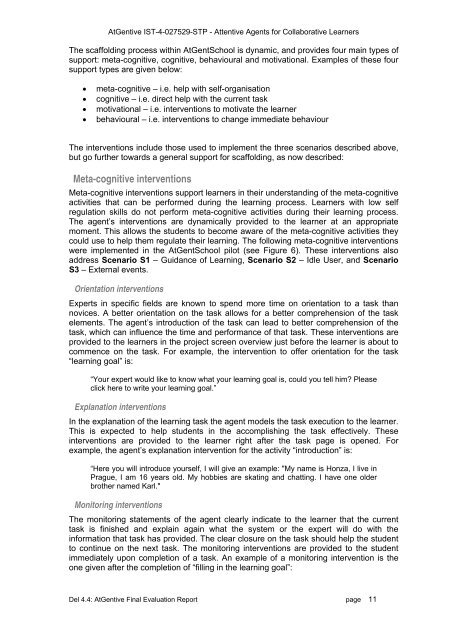Deliverable 4.4 - INSEAD CALT
Deliverable 4.4 - INSEAD CALT
Deliverable 4.4 - INSEAD CALT
You also want an ePaper? Increase the reach of your titles
YUMPU automatically turns print PDFs into web optimized ePapers that Google loves.
AtGentive IST-4-027529-STP - Attentive Agents for Collaborative LearnersThe scaffolding process within AtGentSchool is dynamic, and provides four main types ofsupport: meta-cognitive, cognitive, behavioural and motivational. Examples of these foursupport types are given below:• meta-cognitive – i.e. help with self-organisation• cognitive – i.e. direct help with the current task• motivational – i.e. interventions to motivate the learner• behavioural – i.e. interventions to change immediate behaviourThe interventions include those used to implement the three scenarios described above,but go further towards a general support for scaffolding, as now described:Meta-cognitive interventionsMeta-cognitive interventions support learners in their understanding of the meta-cognitiveactivities that can be performed during the learning process. Learners with low selfregulation skills do not perform meta-cognitive activities during their learning process.The agent’s interventions are dynamically provided to the learner at an appropriatemoment. This allows the students to become aware of the meta-cognitive activities theycould use to help them regulate their learning. The following meta-cognitive interventionswere implemented in the AtGentSchool pilot (see Figure 6). These interventions alsoaddress Scenario S1 – Guidance of Learning, Scenario S2 – Idle User, and ScenarioS3 – External events.Orientation interventionsExperts in specific fields are known to spend more time on orientation to a task thannovices. A better orientation on the task allows for a better comprehension of the taskelements. The agent’s introduction of the task can lead to better comprehension of thetask, which can influence the time and performance of that task. These interventions areprovided to the learners in the project screen overview just before the learner is about tocommence on the task. For example, the intervention to offer orientation for the task“learning goal” is:“Your expert would like to know what your learning goal is, could you tell him? Pleaseclick here to write your learning goal.”Explanation interventionsIn the explanation of the learning task the agent models the task execution to the learner.This is expected to help students in the accomplishing the task effectively. Theseinterventions are provided to the learner right after the task page is opened. Forexample, the agent’s explanation intervention for the activity “introduction” is:“Here you will introduce yourself, I will give an example: "My name is Honza, I live inPrague, I am 16 years old. My hobbies are skating and chatting. I have one olderbrother named Karl."Monitoring interventionsThe monitoring statements of the agent clearly indicate to the learner that the currenttask is finished and explain again what the system or the expert will do with theinformation that task has provided. The clear closure on the task should help the studentto continue on the next task. The monitoring interventions are provided to the studentimmediately upon completion of a task. An example of a monitoring intervention is theone given after the completion of “filling in the learning goal”:Del <strong>4.4</strong>: AtGentive Final Evaluation Report page 11
















